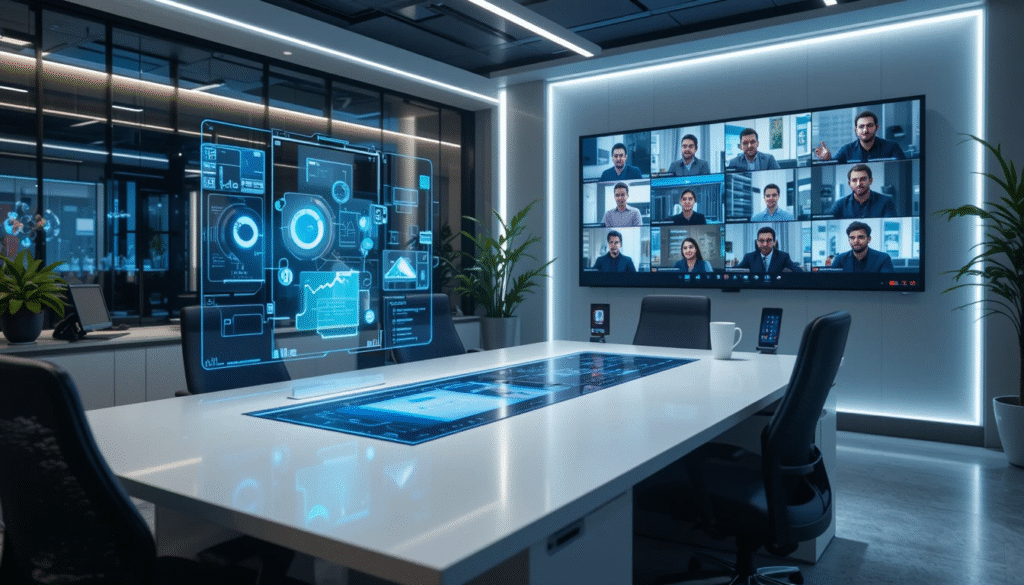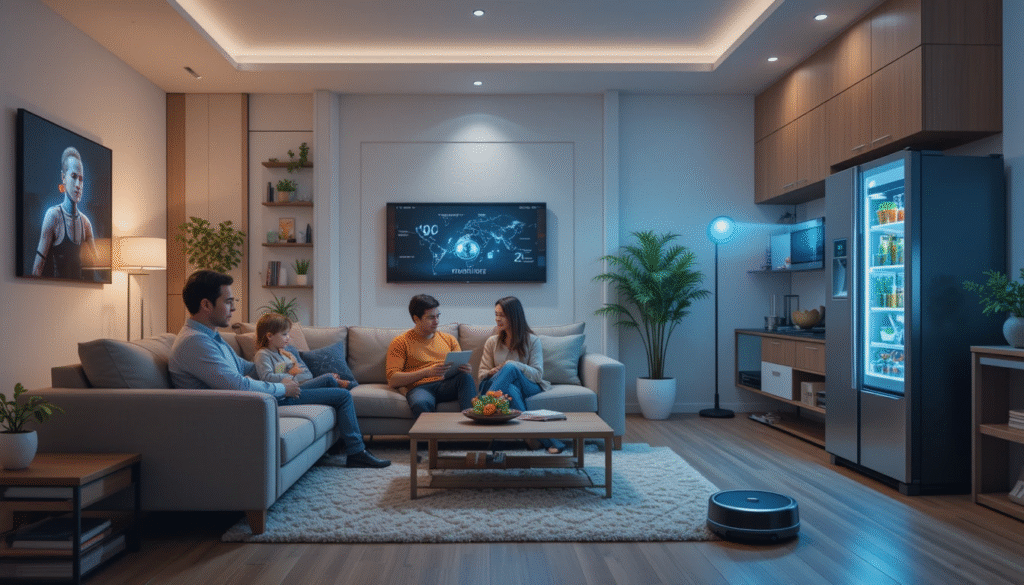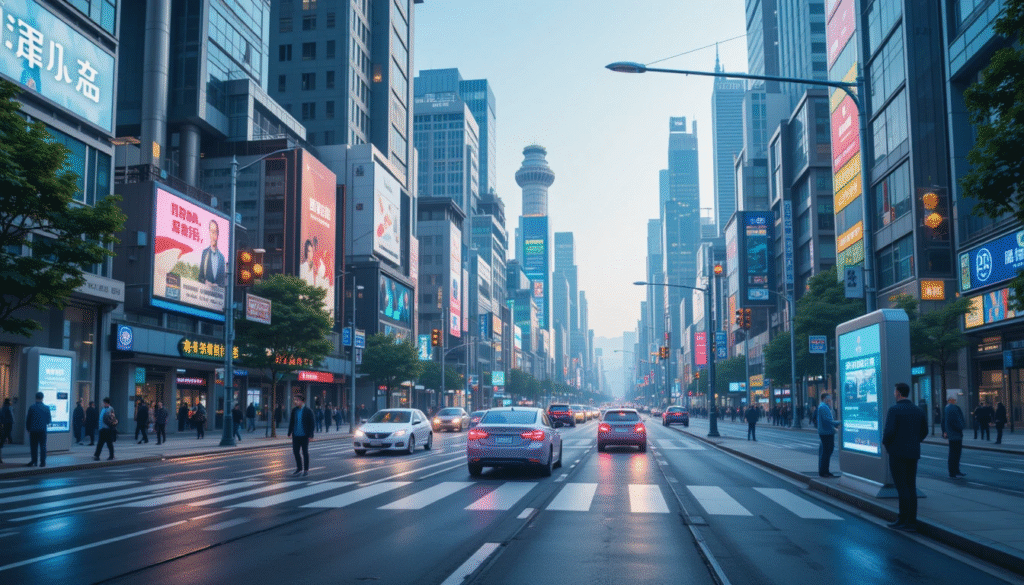Living with AI in 2025
Just a few years ago, artificial intelligence seemed like a buzzword—something relegated to sci-fi movies, tech labs, or Silicon Valley keynotes. Fast forward to 2025, and AI is no longer just futuristic speculation—it’s an integral part of our everyday lives. From the AI-curated news briefings we wake up to, to the personalized playlists that unwind our evenings, AI isn’t just a tool; it’s a companion, a co-worker, and often, a silent decision-maker that shapes our routines.
In this post, we’ll explore how AI is transforming the way we work, live at home, and interact within society. Whether you’re working in a smart office, using AI to manage your household, or witnessing the evolution of AI in urban planning, the revolution is here. But with all its convenience and capability, we also face new questions: What are the benefits? What are the risks? And how do we strike a balance?
AI at Work: A New Era of Productivity and Collaboration
In 2025, the workplace is no longer defined by cubicles and long commutes. Instead, it’s a blend of digital environments, smart tools, and seamless human-AI teamwork. Artificial intelligence has become a vital part of how we work—not by replacing us entirely, but by enhancing our capabilities and streamlining tasks. Whether you’re in a startup or a global corporation, chances are, you’re already collaborating with AI, often without even realizing it.
One of the most noticeable changes is the rise of AI-powered productivity tools. Virtual assistants now do much more than set reminders—they schedule meetings based on everyone’s availability, summarize calls in real-time, and even flag important emails or documents based on your work habits. For teams working remotely or across time zones, AI bridges the gap with automatic translation, emotion detection in video calls, and smart note-taking.
But AI’s impact doesn’t stop at convenience. It’s transforming the very nature of jobs. Routine tasks like data entry, reporting, and even customer support have become more automated, allowing human workers to focus on creative thinking, strategy, and innovation. As some roles phase out, new ones are emerging—jobs requiring skills in AI oversight, data interpretation, and ethical decision-making. Upskilling and adaptability are now essential to staying relevant in this AI-enhanced job market.
In short, AI at work isn’t just a futuristic concept—it’s a practical, present-day reality. The key to success isn’t competing with AI, but learning how to collaborate with it effectively.

AI at Home: Smarter Living, Personalized Convenience
In 2025, our homes have evolved into more than just places to eat, sleep, and relax—they’ve become intelligent environments that learn from us, adapt to our routines, and quietly make life more convenient. Thanks to AI, the concept of a “smart home” has moved far beyond voice commands for lights or thermostats. Now, AI is integrated into nearly every corner of our domestic life, delivering a level of personalization that once seemed like science fiction.
Consider daily routines. Your home assistant no longer just responds to commands—it anticipates them. It might adjust the room temperature before you even think to ask or remind you to grab an umbrella when it senses rain in the forecast. Kitchen appliances suggest meals based on what’s in your fridge and dietary goals, while robotic vacuums clean based on traffic patterns and real-time mess detection.
Health and wellness are also key touchpoints for AI at home. Wearables sync with home systems to monitor sleep patterns, stress levels, and physical activity, offering tailored recommendations to improve your well-being. AI-powered fitness programs adapt workouts in real-time based on your performance, and even provide motivational coaching based on your mood or energy level.
However, this personalized convenience raises important questions about data and privacy. With AI constantly learning from your habits, preferences, and even biometric data, it’s crucial to consider where that information goes and how it’s used. As AI becomes more integrated into our lives, finding the balance between convenience and control over personal data becomes key.
In short, AI at home isn’t just about smart gadgets—it’s about creating an environment that understands and supports your lifestyle. As technology continues to evolve, our homes are becoming more responsive, intuitive, and aligned with how we live.

AI in Society: Systems, Cities, and Everyday Interactions
Beyond the walls of our homes and offices, artificial intelligence is reshaping the very fabric of society. In 2025, AI operates largely behind the scenes—but its influence is pervasive. From smarter cities to more responsive public services, AI is playing a vital role in how communities function, how people connect, and how systems adapt to real-time needs.
Cities, for example, are becoming more efficient and sustainable thanks to AI. Traffic signals adjust dynamically based on congestion patterns. Public transportation systems use predictive analytics to optimize routes and schedules, reducing wait times and carbon emissions. Waste management is also getting a boost, with AI analyzing fill levels in bins and scheduling collections only when necessary. These improvements may not always be visible to residents, but they lead to smoother, cleaner, and safer urban environments.
In education, AI is helping to close gaps and personalize learning at scale. Students in traditional classrooms and online platforms benefit from adaptive learning systems that adjust content to their individual strengths and weaknesses. Teachers use AI-driven insights to identify students who need extra support or are ready for more advanced material. Similarly, healthcare systems are using AI to prioritize cases, predict outbreaks, and assist in diagnostics, making care more proactive and accessible.
However, as AI becomes more embedded in public life, it brings complex challenges—especially regarding ethics, transparency, and equity. Algorithmic bias can reinforce inequalities if not carefully monitored. Surveillance tools powered by AI raise concerns about privacy and civil liberties, especially when used without clear oversight. While automation improves service delivery, it also risks leaving behind communities without access to digital tools or literacy.
At its best, AI in society has the potential to create more responsive, efficient, and inclusive systems. But realizing that potential requires making thoughtful choices about how the technology is designed, implemented, and governed. As individuals and as a collective, we all play a role in shaping an AI-powered world that works for everyone.

Conclusion: Living with AI—The Future is Now
Artificial intelligence in 2025 isn’t just transforming isolated parts of our lives—it’s reshaping how we work, live, and interact with the world. At work, AI enhances productivity and enables new forms of collaboration. At home, it offers personalized convenience and smarter living. Across society, AI helps cities operate more efficiently and public services respond more intelligently, all while raising important ethical and social questions.
As AI continues to evolve, we must actively engage with it. Staying informed, asking critical questions, and being intentional about how we use and shape these technologies is essential. Whether you’re a professional integrating AI tools, a parent managing a smart home, or a citizen navigating AI-driven systems, your choices and voice matter in shaping a future where AI serves everyone fairly and responsibly.
Now is the time to understand AI—not just as a technology, but as a force that’s becoming part of our everyday lives. How will you live with it?
